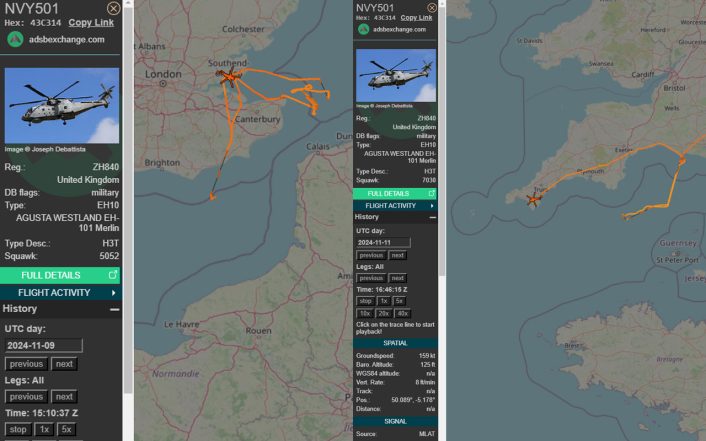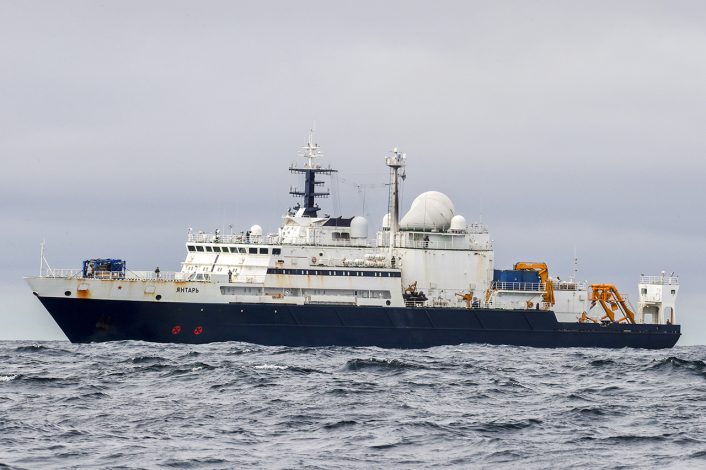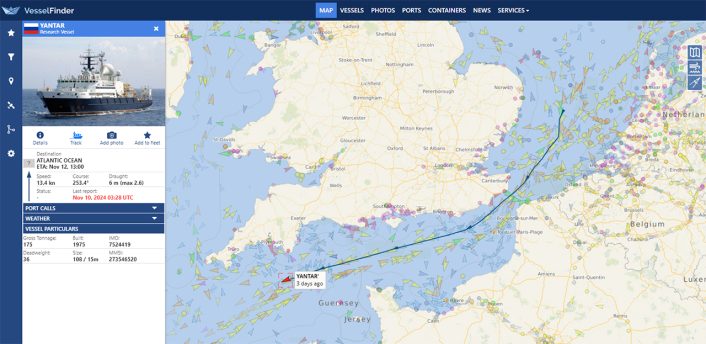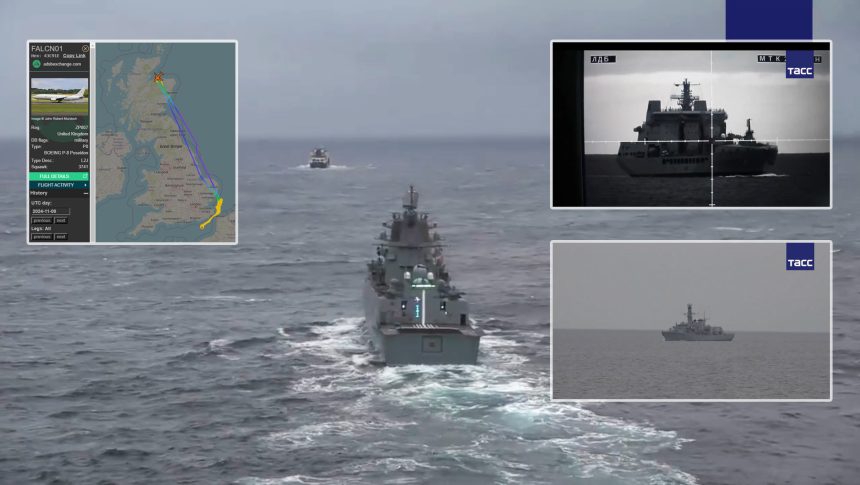Frigate Admiral Golovko, tanker Vyazma, and intelligence ship Yantar were traced heading westwards through the Channel by frigate HMS Iron Duke, Merlin HM2 helicopters and RAF P-8 Poseidons.
After departing the Northern Fleet base of Severomorsk on Nov. 1, 2024, the brand new Russian Navy Project 22350 frigate Admiral Golovko (pennant number 456) and accompanying replenishment tanker Vyazma transited the English Channel heading west on Nov. 9.
Fleet Ready Escort HMS Iron Duke escorting Russian convoy westbound through the English Channel today.
Russian tanker Vyazma, and research ship Yantar escorted by frigate RFS Admiral Golovko.
(Src/img: Dover Strait Shipping https://t.co/r7VOTvCyl8) pic.twitter.com/nN8iRLcWVO
— UK Forces Tracker (@UKForcesTracker) November 9, 2024
Having been commissioned in only December last year, the Golovko is of significant intelligence value to NATO militaries. While being of approximately the same size as the Type 23 Duke class frigate dispatched by the Royal Navy to monitor it, Admiral Golovko is quite significantly more heavily armed.
Like the previous two vessels of its class, the frigate is equipped with two banks of eight vertical launch system cells dedicated for launching cruise missiles. This reportedly includes the Zircon missile, which Russia claims to have a range of 1000km and hypersonic speed capabilities. In addition are 32 cells for surface to air missiles, a 130mm A-192M main gun, two 30mm Palash CIWS mounts, and eight torpedo launchers.
Following standard Russian Navy practice, the tanker Vyazma will support the frigate on a long duration deployment with fuel and other stores. This is the first time the Admiral Golovko has deployed on such an operation. A previous deployment by sister ship Admiral Gorshkov in the summer of 2024 also attracted NATO attention, though this mission did not include an English Channel transit.
The crew of the Gorshkov-class frigate Admiral Golovko (Pr. 22350) carried out ASW and anti-aircraft exercises during the passage of the English Channel and also conducted a training rescue operation with the use of Ka-27 helicopters.
📹: MoD RF https://t.co/W6OQDZJRld pic.twitter.com/gJHifX0fFK
— Massimo Frantarelli (@MrFrantarelli) November 12, 2024
While it is normal procedure for the Royal Navy to shadow Russian movements in the Channel, it is not as common to see a constant patrol additionally maintained by RAF P-8 Poseidon MRA1 maritime patrol aircraft. Flying from RAF Lossiemouth, Poseidons traced the movements of the Russian ships from the northernmost reaches of the North Sea through to the exit of the Channel into the Atlantic Ocean, south of Cornwall.
These aircraft were apparently joined by a Royal Navy Merlin HM2 naval helicopter operating from the shore. The Merlin HM2 is equipped with a powerful 360-degree Blue Kestrel 5000 surveillance radar designed for maritime operations, and can also be equipped with a WESCAM electro-optical/infrared camera turret.

An unknown contribution was also made to the operation by the Royal Netherlands Navy.
According to Russian state media, the Golovkov and its support ship are heading to “demonstrate the flag and ensure a naval presence in operationally important areas of the distant ocean zone”. The mission is likely to include port visits in nations friendly to Russia surrounding the Atlantic Ocean.
Intelligence gathering
As the British military took the opportunity to gather intelligence on the Russian Navy’s newest frigate, Russia in turn also sailed its mysterious intelligence vessel Yantar through the Channel. Yantar is no stranger to UK waters, having been a familiar sight through the maritime choke-point as well as in exercise areas off the coast for many previous years.

The exact capabilities of Yantar are relegated mostly to speculation, but it is known that the ship has spent time operating in the vicinity of important undersea cables. Officially, Yantar is operated by the Directorate of Underwater Research. Equipment visible on the ship, analysed in detail by H I Sutton, denotes the likely operation of remote underwater vehicles which could be used to intercept or even cut these communications cables, as well as disrupt other critical underwater infrastructure like sonar networks. Tags used by the UK Ministry of Defence for images of the Yantar on its media repository reveal the use of the classification AGI, standing for Auxiliary, General Intelligence.
On this occasion, it would seem likely that Yantar’s attention was turned mostly to the surface of the water, operating close to the USS Harry S. Truman carrier strike group as well as the Royal Navy’s HMS Queen Elizabeth aircraft carrier which is currently operating in the channel after departing HMNB Portsmouth on Nov. 4.
Fortunately for civilian observers, the Yantar operated through the channel and as far as Plymouth with its AIS transponder operational. This allows the vessel to be tracked by public receivers, raising the attention of local media outlets.

Careful considerations on both sides would have played into deciding which intelligence gathering capabilities to use and which to not use, so as to not present the opportunity for the adversary to learn too much about more advanced capabilities.
It is possible that some of this surveillance took place beneath the waves. Although the presence of Russian submarines in the vicinity cannot be confirmed, it is public knowledge that three Royal Navy attack submarines are currently at sea. HMS Triumph, the sole remaining Trafalgar class submarine in service, departed HMNB Devonport on Nov. 6, just three days before the Russian vessels transited to the south of the port. Astute class submarines HMS Astute and HMS Anson also recently put to sea from HMNB Faslane in Scotland, ending a spell where the Royal Navy had no active attack submarines.
A gloomy grey day here this morning… @RFATidespring offshore SOBW doing boat transfer and the odd ‘sewer pipe’ outbound shortly after sunrise. pic.twitter.com/zaWUYrPNtX
— RFANostalgia (@RfaNostalgia) November 6, 2024
Eastbound Transit
Rounding off several days of intense activity in UK waters, on Nov. 11 the Project 11540 Yastreb frigate Neustrashimy transited the English Channel, with support vessel Akademik Pashin, in the opposite direction, likely en route back to Russia. The frigate sailed from its Baltic Fleet homeport in Kaliningrad in April 2024, stopping in Cuba in the following July, then South Africa in October.
🔺OOA activity
Russian Navy Northern Fleet tanker “Akademik Pashin”, highly likely in company with Baltic Fleet SKR-772 “ Neustrashimy”, entered the NSEA, via Dover Strait northbound passage, early AM 11 November 2024.
Both vessels ENR RTP from deployment. @shipohollic pic.twitter.com/EbuBzk7FMF
— Droxford Maritime (@Drox_Maritime) November 11, 2024
Neustrashimy, currently wearing pennant number 772, is a much older design than the Admiral Golovko, dating from the early 1990s. It lacks the offensive cruise missile armament of the newer frigate, carrying only a short range surface to air missile armament alongside its 100mm gun, torpedo launchers, CIWS, and anti-submarine rockets.
Nonetheless, its movements were again shadowed by NATO forces. An RAF P-8 Poseidon MRA1 was again spotted using ADS-B flight trackers operating in the vicinity of the vessels’ reported positions.
UK P-8 MRA1 ZP807 #43C91E as FALCN02 out over the North Sea.
RUS Navy Northern Fleet tanker Akademik Pashin, likely with Baltic Fleet SKR-772 Neustrashimy, is transiting the North Sea.@sipjack1776 @auonsson @thereccelizard pic.twitter.com/tltPguM9ik
— Johnny Gemini (@Borrowed7Time) November 11, 2024
The day prior, Portuguese officials announced that the frigate NRP António Enes and patrol vessel NRP Figueira da Foz had shadowed the two vessels for a number of days as they approached the English Channel.









